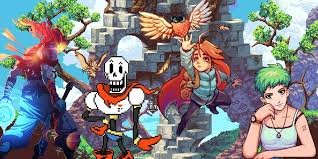Indie Games are the new dominating trend when it comes to the diversity of game genres. The gaming world of 2025 is undergoing a radical transformation, with independent (indie) games not only holding their own, but leading the debate and fueling the imagination of players worldwide. It's not a temporary phenomenon, but the culmination of a series of powerful forces that allow small teams and individual developers to deliver experiences that more often than not overshadow their AAA counterparts.
The Attraction of Unbridled Innovation and Creativity in Indie Games Dominating the Market
Some of the strongest arguments as to why indie games have such a rising popularity, their reign supreme lies in their unrivaled creative freedom. Unlike major studios with enormous budgets, strict timetables, and the pressure to cater to a wide, sometimes risk-averse audience, indie devs can actually make what they want. This results in:
- Innovative Concepts and Daring Stories: Independent games are the breeding ground for new storytelling, trying out niche game genres, and taking risks that larger publishers would deem too risky. This means games that are new, engaging, and incredibly personal. Games like Hades (though released earlier, its popularity and impact are inescapable) and Unpacking are the epitome of this, providing new experiences that speak to the player.
- Beyond Hyper-Realism Vision: Whereas AAA games (high-budget, high profile titles) usually strive for photorealism, indie developers embrace distinctive art styles – from adorable pixel art to hand-drawn ones – to create enduring visual identities. This vision makes them stand out in a saturated market and create a stronger emotional connection with players.
- Gameplay Innovation: Without the need to reuse tested mechanics, independent developers are able to innovate gameplay loops, introduce new systems, and concentrate on engaging player interactions. This focus on core mechanics can lead to highly engaging and rewarding games, as seen in the surprise hits of titles such as Vampire Survivors.
Indie Games Promoting Shifts in Player Trends and Market Trends
The gaming public itself has changed, and the soil is fertile now for indie games:
- Authenticity and Connectedness: Gamers in 2025 are increasingly seeking out authentic experiences and a feeling of connectedness to the creators. Indie games, being made by passionate developers or small teams, have an intimacy and sense of authenticity that the bigger, more corporate ventures cannot.
- Accessibility and Discoverability: Digital distribution platforms like Steam, itch.io, and console stores (Nintendo Switch remains an “indie darling”) https://gamefaqs.gamespot.com/boards/189706-nintendo-switch/80897504?page=1 have leveled the playing field of game publishing. It provides smaller developers with access to a worldwide market audience without the assistance of major publishers or retail distribution. Discoverability still is an issue due to market saturation, but clever marketing through social media, game festivals, and influencer partnerships can draw attention to indie games.
- Fatigue of AAA Monotony and Monetization: A prevailing sense of dissatisfaction among players is an expression of a sense of lack of innovation and overwhelming use of aggressive monetization strategies (battle passes, microtransactions, etc.) in the AAA market. Indie titles, with their tendency to deliver complete experiences without the pressure of such, are a welcome respite.
- Rise of “Short, Polished” Experiences: The majority of gamers are looking towards shorter, highly polished standalone single-player independent games that offer a good experience without the massive time commitment or grinding of live-service AAA games.
Technological Development and Ecosystem in 2025
The 2025 technology environment also supports standalone developers:
- Low-Cost and Powerful Tools: Game engines like Unity and Unreal Engine, and a set of low-cost and free development tools, have lowered the barrier of entry significantly for aspiring game developers. It is now affordable for even small teams or single developers to develop decent games.
- AI for Efficiency: Generative AI technologies are starting to be used in game development to assist with tasks like asset creation, writing dialogue, and even testing. It enables indie studios to do more with less, possibly speeding up development and enabling richer content.
- Community-Driven Development and Post-Launch Support: Indie developers build passionate, dedicated communities around their titles. They take feedback proactively during beta and early access, resulting in community-driven development and player ownership. Regular post-launch support in the form of updates and new content reinforces these communities and helps ensure long-term success.
Economic Realities and Strategic Agility
Commerially speaking, independent games have inherent advantages within the current market:
- Lower Risk, Higher Agility: With fewer budgets and personnel, independent studios have more flexibility to take risks creatively. If something doesn't pan out, they can change quickly without the disastrous losses of a failed AAA venture. This makes them more agile to react to market shifts and player critique.
- Niche Market Targeting: Indie games can succeed by targeting specialist niches and player tastes that may be ignored by bigger studios chasing broad popularity.
- Word-of-Mouth Potential for Success: With the internet age, it is now feasible for an incredibly great and well-crafted indie game to become viral through word-of-mouth, streaming, and social media, reaching an extremely large audience organically. Briefly put, the indie game reign of 2025 is not an accident. It's a testament to the strength of creative autonomy, the changing needs of the audience, and the growing ease of development tools. As the industry matures further, indie games are proving that passion, creativity, and a personal connection with the audience are the real keys to unlocking the most thrilling and influential experiences in gaming.









